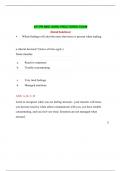Summary
Summary Mood, Anxiety & Psychotic Disorders Lecture 1-6
- Course
- Institution
This summary is based on the learning objectives of the lectures and entails the following subjects: introduction to mood, anxiety & psychotic disorders, models of depression & anxiety, interpersonal processes, biological models and best evidence and practice in mental health services.
[Show more]












